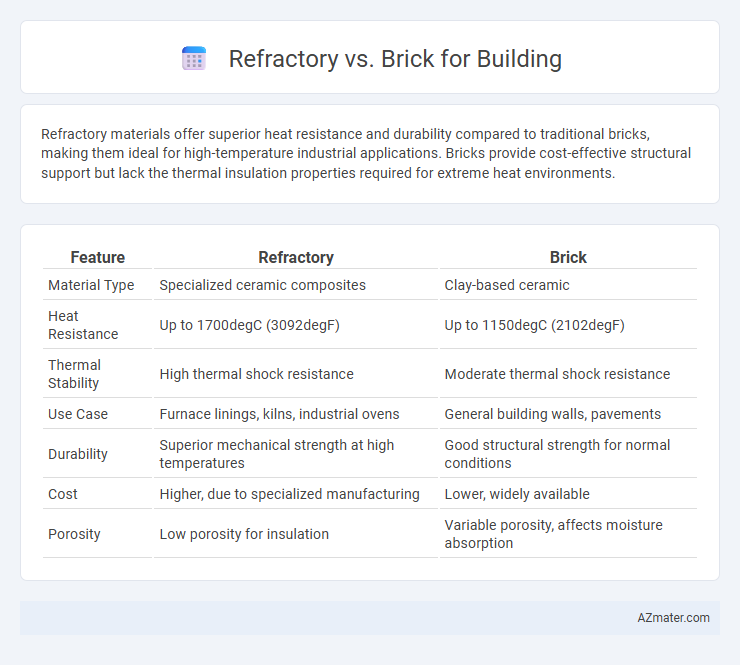Refractory materials offer superior heat resistance and durability compared to traditional bricks, making them ideal for high-temperature industrial applications. Bricks provide cost-effective structural support but lack the thermal insulation properties required for extreme heat environments.
Table of Comparison
| Feature | Refractory | Brick |
|---|---|---|
| Material Type | Specialized ceramic composites | Clay-based ceramic |
| Heat Resistance | Up to 1700degC (3092degF) | Up to 1150degC (2102degF) |
| Thermal Stability | High thermal shock resistance | Moderate thermal shock resistance |
| Use Case | Furnace linings, kilns, industrial ovens | General building walls, pavements |
| Durability | Superior mechanical strength at high temperatures | Good structural strength for normal conditions |
| Cost | Higher, due to specialized manufacturing | Lower, widely available |
| Porosity | Low porosity for insulation | Variable porosity, affects moisture absorption |
Introduction to Refractory and Brick Materials
Refractory materials are specially designed to withstand extremely high temperatures, making them essential for furnace linings, kilns, and reactors, while bricks are primarily composed of clay or concrete and used for general construction purposes. Refractories contain dense minerals like alumina and silica, providing thermal resistance and durability, whereas bricks offer structural support and aesthetic appeal in building walls and pavements. Understanding the distinct composition and thermal properties of refractory and brick materials is crucial for selecting the right material in high-heat versus standard construction applications.
Composition and Properties: Refractories vs Bricks
Refractories are made from specialized ceramic materials such as alumina, silica, and magnesia, designed to withstand extreme temperatures, thermal shock, and chemical corrosion, making them ideal for furnaces and kilns. Traditional bricks primarily consist of clay or shale and are fired at lower temperatures, resulting in lower thermal resistance and mechanical strength compared to refractory materials. The high refractory index and thermal stability differentiate refractories from bricks, enabling their use in industrial high-heat environments where structural integrity and durability are crucial.
Types of Refractory Materials Used in Construction
Refractory materials used in construction primarily include fireclay bricks, silica bricks, and insulating firebricks, each chosen for their high thermal resistance and durability in extreme heat environments. Fireclay bricks are composed of alumina and silica and offer excellent resistance to thermal shock, making them ideal for furnaces and kilns. Silica bricks provide superior refractoriness and resistance to chemical attack, while insulating firebricks, made from lightweight materials, offer better thermal insulation for energy-efficient applications.
Common Uses of Traditional Bricks in Building
Traditional bricks are commonly used in residential and commercial building construction due to their durability, thermal insulation, and aesthetic appeal. They are ideal for constructing walls, facades, and fireplaces, providing structural strength and weather resistance. Unlike refractory bricks, which withstand high temperatures in furnaces and kilns, traditional bricks excel in general building applications where fire resistance is moderate.
Heat Resistance: A Comparative Analysis
Refractory materials exhibit superior heat resistance compared to standard bricks, withstanding temperatures above 1600degC without degradation, making them ideal for furnaces and kilns. Bricks, typically composed of clay fired at lower temperatures, resist heat up to approximately 1000degC but can crack or spall under extreme thermal stress. The thermal conductivity and melting point differences significantly influence their performance in high-temperature construction applications.
Durability and Longevity Factors
Refractory materials exhibit superior durability and longevity compared to traditional bricks due to their high resistance to extreme temperatures, chemical corrosion, and mechanical wear, making them ideal for industrial furnace linings and high-heat environments. Bricks, while cost-effective and versatile in general construction, tend to degrade faster under thermal stress and exposure to harsh elements, limiting their lifespan in high-temperature applications. The enhanced thermal stability and structural integrity of refractory materials ensure prolonged service life and reduced maintenance needs, critical factors in demanding building projects.
Installation Methods and Challenges
Refractory materials require precise installation techniques such as casting, gunning, or ramming to withstand extreme temperatures and prevent structural failure in high-heat environments. Brick installation, typically involving mortar layering and standard masonry techniques, poses fewer challenges but demands attention to alignment and joint integrity for durability and aesthetic appeal. Refractory installation challenges often include ensuring proper curing times and thermal expansion allowances, while brickwork primarily contends with weather exposure and consistent bonding strength.
Cost Considerations: Refractory vs Brick
Refractory materials typically have higher upfront costs compared to traditional bricks due to their specialized composition and enhanced heat resistance, making them ideal for high-temperature applications such as furnaces and kilns. While bricks offer a more economical option for general construction with lower initial investment, their reduced durability in extreme heat can lead to increased maintenance and replacement expenses over time. Evaluating the total cost of ownership, including durability, thermal performance, and maintenance frequency, is crucial when choosing between refractory materials and bricks for building projects.
Environmental Impact and Sustainability
Refractory materials typically contain alumina and silica, offering high thermal resistance but often require energy-intensive manufacturing processes that result in larger carbon footprints compared to traditional clay bricks. Bricks made from natural clay are more biodegradable and can be produced with lower energy consumption, enhancing their sustainability profile. Choosing materials with minimal environmental impact depends on lifecycle assessments, including raw material extraction, production emissions, durability, and recyclability.
Choosing the Right Material: Key Takeaways
Choosing between refractory and brick materials hinges on temperature resistance and application requirements; refractory bricks withstand extreme heat up to 3,000degF, ideal for furnaces and kilns, while standard bricks suit lower temperature environments. Durability, thermal conductivity, and cost-effectiveness also influence material selection, with refractory bricks offering superior insulation and longevity in high-heat settings. Assessing specific project conditions ensures optimal performance and safety when selecting building materials.

Infographic: Refractory vs Brick for Building
 azmater.com
azmater.com